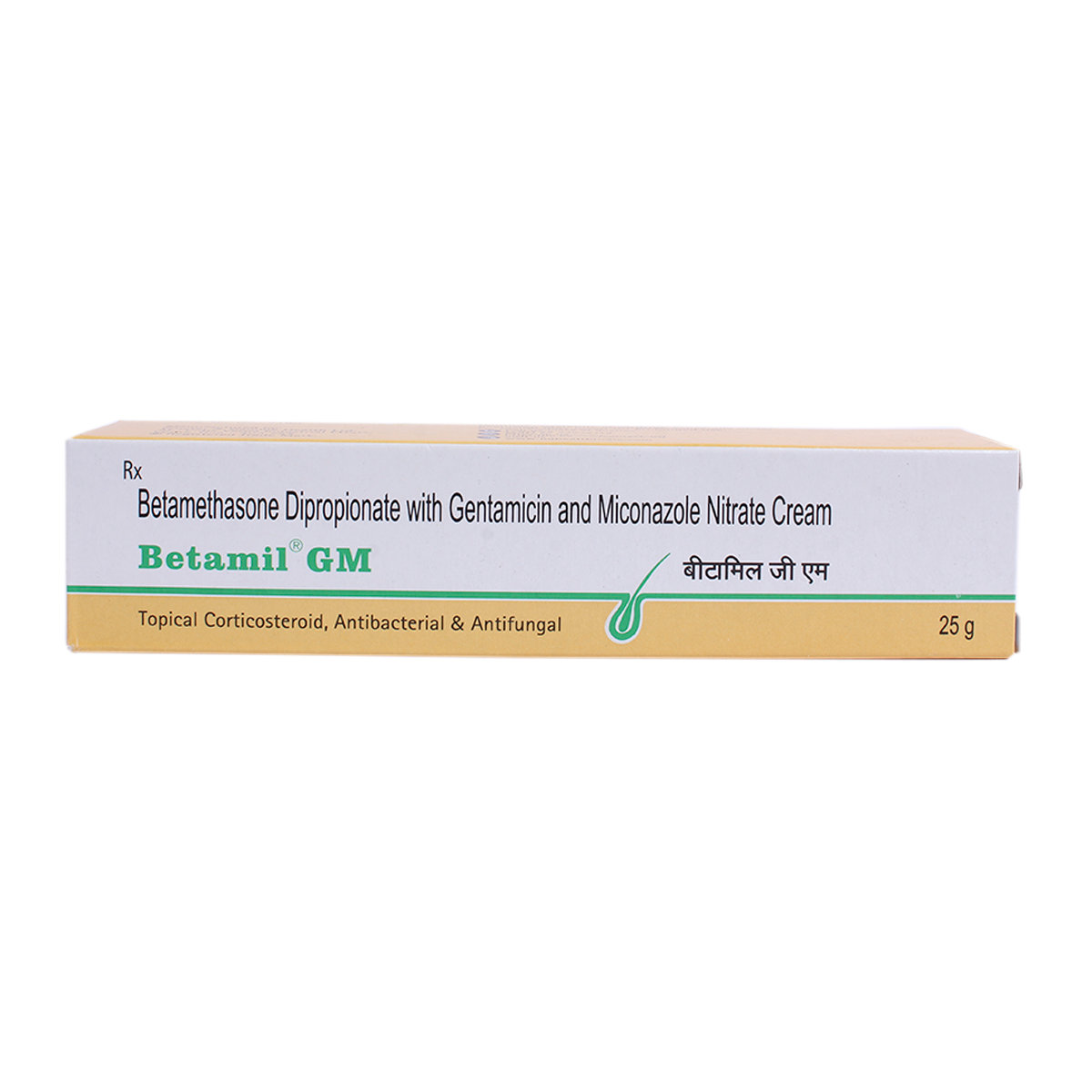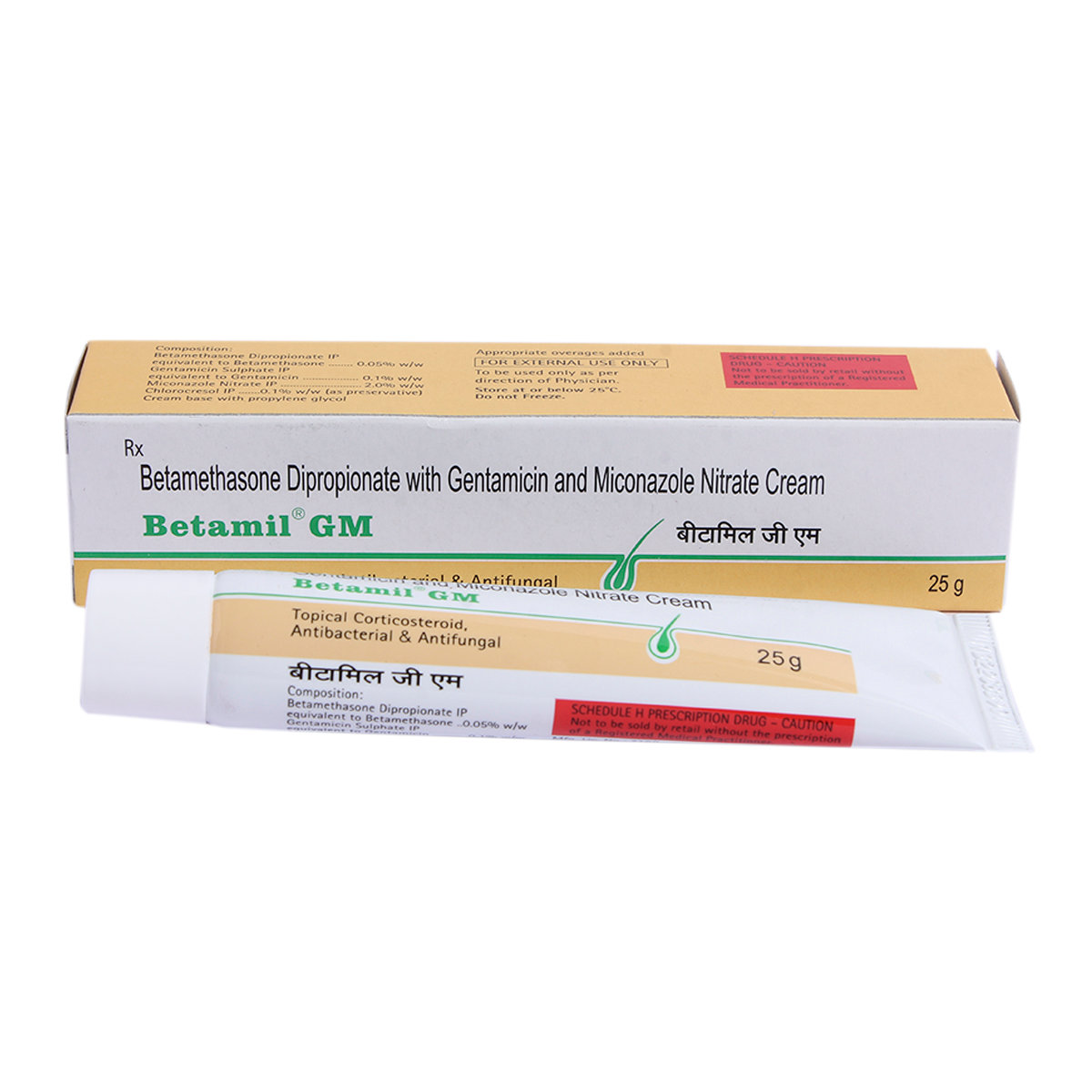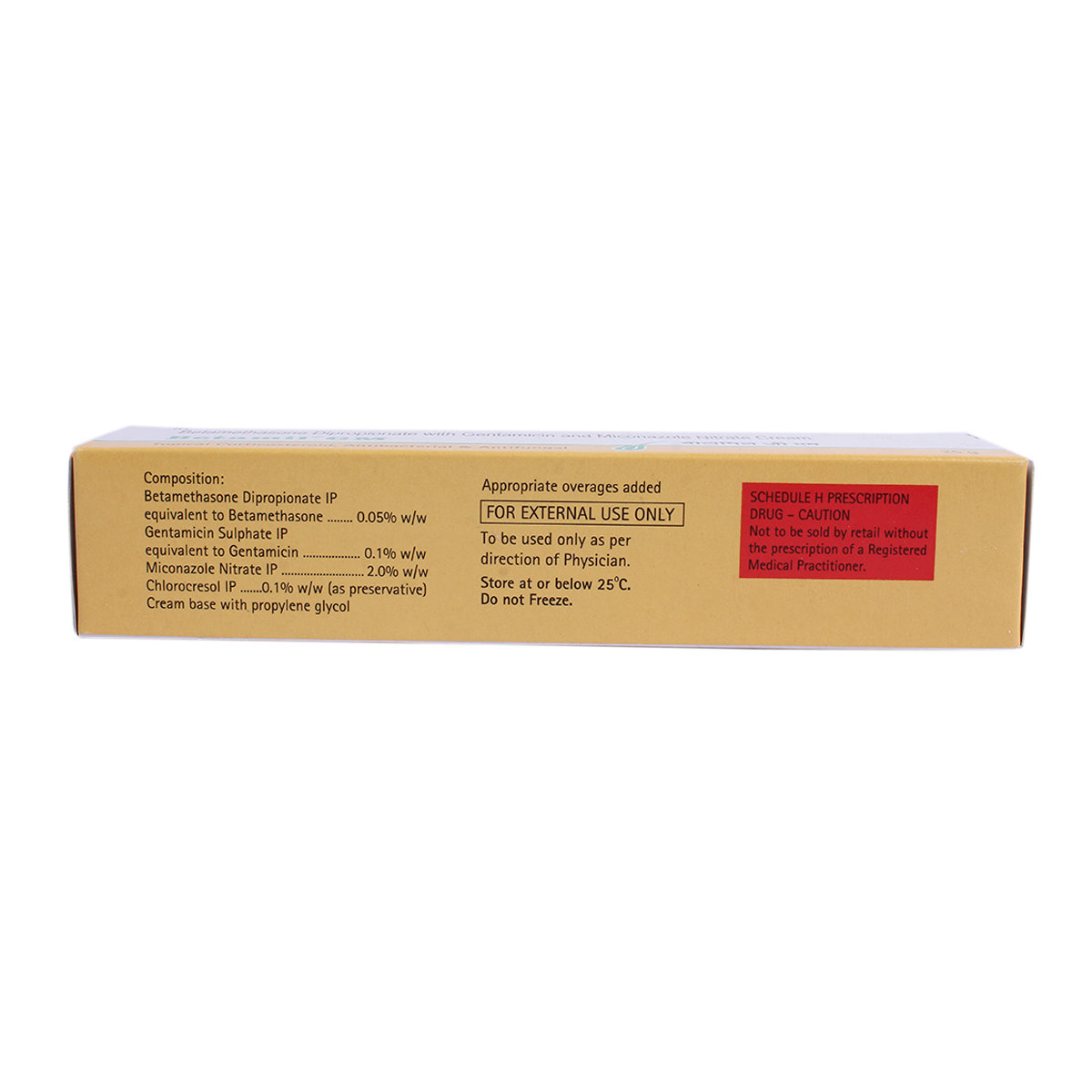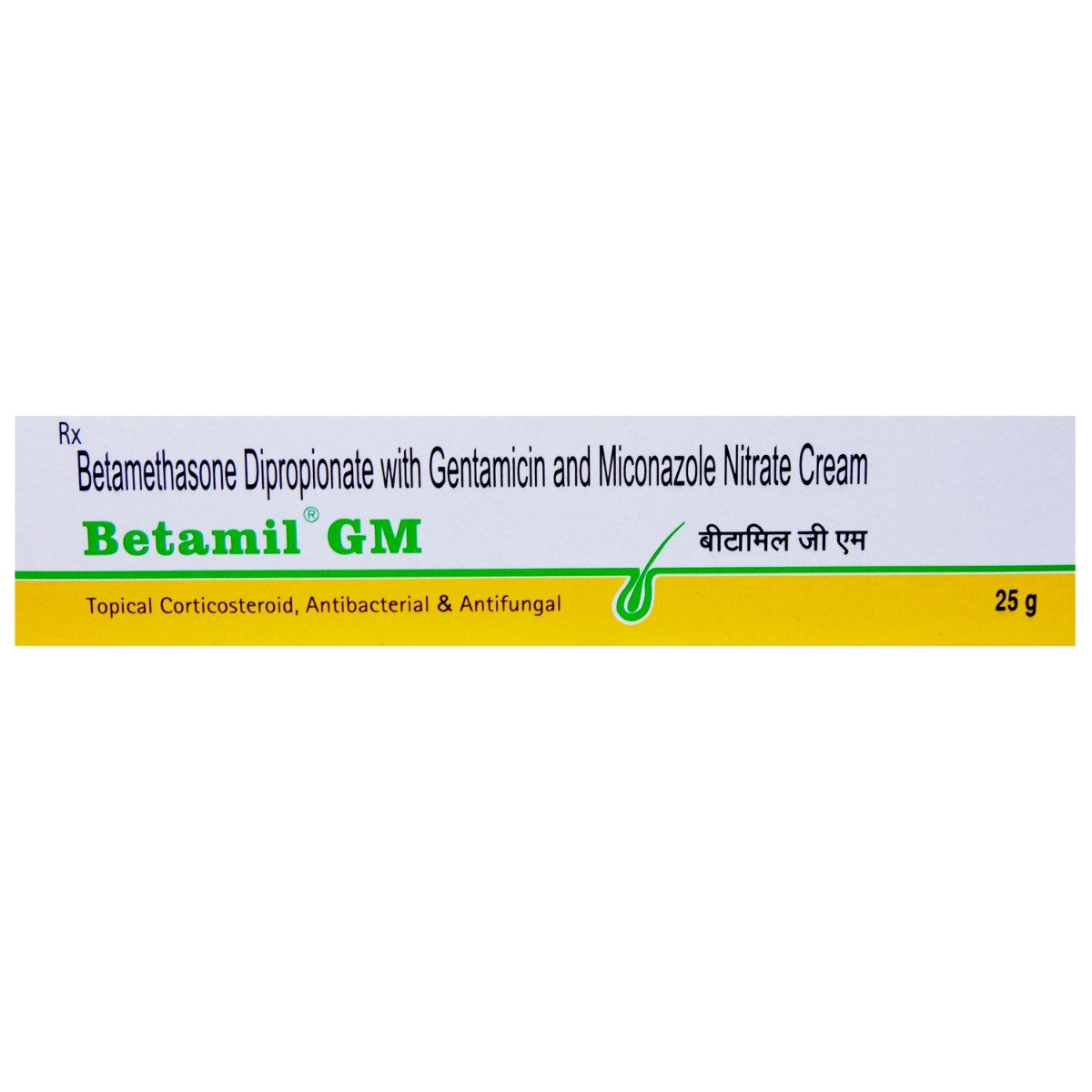Betamil GM Cream 25 gm








MRP ₹54
(Inclusive of all Taxes)
₹8.1 Cashback (15%)
Selected Pack Size:25 gm
25 gm ₹48.6
(₹1.94 / 1 gm)
In Stock
30 gm ₹48.6
(₹1.62 / 1 gm)
In Stock
20 gm ₹42.75
(₹2.14 / 1 gm)
Out of stock
Provide Delivery Location
Online payment accepted
 Prescription drug
Prescription drugWhats That
Manufacturer/Marketer :
Consume Type :
Return Policy :
Expires on or after :
About Betamilgm Cream
Betamilgm Cream belongs to a class of dermatological medication ‘Topical Anti-Infectives with Corticosteroids’ used to treat skin conditions like eczema (itchy inflamed skin), psoriasis (red, itchy, scaly patch on skin), and other types of rash. Also, Betamilgm Cream helps to reduce swelling, itching, and redness caused due to specific skin problems. Fungal infection is a skin disease in which a fungus attacks the tissue and causes infection. Fungal infections may be contagious (spread from one person to another). Bacterial infection is a condition in which harmful bacteria grow in the body and cause infection. It can infect any part of the body and multiply very quickly.
Betamilgm Cream is a combination of three drugs, namely Betamethasone (corticosteroid), Gentamicin (antibiotic), and Miconazole (antifungal). Betamethasone belongs to the class of corticosteroids that works by acting inside skin cells and inhibits the release of certain chemical messengers in the body that cause redness, itching, and swelling. When the skin reacts to any allergens, such chemicals are released typically. Gentamicin works by causing bacteria to produce faulty and abnormal proteins. Thereby, kills the bacteria and clears the infection. The fungal cell membranes are essential for their survival as they prevent the entry of unwanted substances into the cells and stop the leakage of cell contents. Miconazole belongs to the class of antifungals that works by causing holes in the fungal cell membranes and kills fungi.
Betamilgm Cream is only for external use. Take a small amount of Betamilgm Cream on the finger and apply it as a thin layer on the clean and dry affected area. Avoid contact of Betamilgm Cream with nose, ears, mouth, or eyes. In case Betamilgm Cream comes in connection with these areas accidentally, rinse with water thoroughly. Some people may experience skin peeling, dry skin, itching, redness, irritation, or burning sensation at the site of application. Most of these side effects of Betamilgm Cream do not require medical attention and gradually resolve over time. However, if the side effects worsen or persist, please consult your doctor.
If you are allergic to Betamilgm Cream, iodine, or any other medicines, please tell your doctor. If you are pregnant or a breastfeeding mother, it is advised to consult a doctor before using Betamilgm Cream. Do not use Betamilgm Cream in more than prescribed doses, or for a prolonged time as it may cause adverse effects. Do not wrap or cover the treated area with airtight dressings unless advised by a doctor. Do not swallow Betamilgm Cream. In case of accidental swallowing, consult a doctor immediately. If you have glaucoma, cataracts, diabetes, adrenal gland or kidney problems, asthma, myasthenia gravis (muscle weakness), Parkinson’s disease, or other skin problems, inform your doctor before taking Betamilgm Cream.
Uses of Betamilgm Cream
Directions for Use
Medicinal Benefits
Betamilgm Cream is a combination of three drugs, namely: Betamethasone, Gentamicin, and Miconazole. Betamilgm Cream is used to treat fungal and bacterial infections of the skin. Also, Betamilgm Cream helps to reduce swelling, itching, and redness caused due to certain skin problems. Betamethasone is a corticosteroid that acts inside skin cells and inhibits the release of certain chemical messengers in the body that cause redness, itching, and swelling. When the skin reacts to any allergens, such chemicals are released normally. Gentamicin is an antibiotic that causes bacteria to produce faulty and abnormal proteins. Thereby, kills the bacteria and clears the infection. The fungal cell membranes are essential for their survival as they prevent the entry of unwanted substances into the cells and stop the leakage of cell contents. Miconazole is an antifungal that works by causing holes in the fungal cell membranes and kills fungi.
Storage
- Report the itching to your doctor immediately; they may need to change your medication or dosage.
- Use a cool, damp cloth on the itchy area to help soothe and calm the skin, reducing itching and inflammation.
- Keep your skin hydrated and healthy with gentle, fragrance-free moisturizers.
- Try not to scratch, as this can worsen the itching and irritate your skin.
- If your doctor prescribes, you can take oral medications or apply topical creams or ointments to help relieve itching.
- Track your itching symptoms and follow your doctor's guidance to adjust your treatment plan if needed. If the itching persists, consult your doctor for further advice.
Drug Warnings
If you are allergic to Betamilgm Cream, iodine, or any other medicines, please tell your doctor. If you are pregnant or a nursing mother, it is advised to consult a doctor before using Betamilgm Cream. Do not use Betamilgm Cream in more than prescribed doses, or for a prolonged time as it may cause adverse effects. Wear disposable plastic gloves or wash your hands after use if you are applying Betamilgm Cream for others. Do not wrap or cover the treated area with airtight dressings unless advised by a doctor. Do not swallow Betamilgm Cream. In case of accidental swallowing, consult a doctor immediately. If you have glaucoma, cataracts, diabetes, adrenal gland or kidney problems, asthma, myasthenia gravis (muscle weakness), Parkinson’s disease, or other skin problems, inform your doctor before taking Betamilgm Cream.
Drug-Drug Interactions
Drug-Drug Interactions
Login/Sign Up
Drug-Food Interactions
Drug-Food Interactions
Login/Sign Up
Diet & Lifestyle Advise
- Regularly change your socks and wash your feet. Avoid shoes that make your feet sweaty and hot.
- In wet places such as changing rooms and gym showers, don’t walk barefoot. Wear flip-flops or sandals to prevent fungal infections.
- Do not scratch the affected area of the skin as it can spread the infection to other body parts.
- Avoid sharing towels, combs, bedsheets, shoes, or socks with others to prevent the spread of infection.
- Wash your bed sheets and towels regularly.
- Eat foods rich in quercetin (a flavonoid) such as apples, cherries, broccoli, spinach, and blueberries.
- Consuming food rich in probiotics helps in developing the immune system against allergies.
- Limit intake of food that might trigger allergies such as dairy products, soy, eggs, and nuts.
- Avoid consumption of foods with excess sugar as it may flare up inflammation.
- Include fruits, vegetables, whole grains, healthy fats, and fish in your diet.
- Avoid getting in contact with harsh soaps, detergents, and rough fabrics.
Side Effects of Betamilgm Cream
- Skin peeling
- Dry skin
- Itching, redness, irritation or burning sensation at the site of application
Habit Forming
Therapeutic Class
All Substitutes & Brand Comparisons
RX
Betamil GM Cream 30 gm
Procter & Gamble Health Ltd
₹54
(₹1.62/ 1gm)
16% CHEAPERRX
Out of StockBetamil GM Cream 20 gm
Merck Ltd
₹47.5
(₹2.14/ 1gm)
10% COSTLIERRX
Dipnate Gm Cream 15gm
Karlin Pharmaceuticals & Exports Pvt Ltd
₹74
(₹4.44/ 1gm)
128% COSTLIER
Product Substitutes
Author Details
We provide you with authentic, trustworthy and relevant information
Drug-Diseases Interactions
Drug-Diseases Interactions
Login/Sign Up
FAQs
No, Betamilgm Cream is not used to treat diaper rash as using Betamilgm Cream under child’s nappy enables Betamilgm Cream to pass through the skin easily and cause adverse effects. However, please consult a doctor before using Betamilgm Cream in children.
Yes, Betamilgm Cream may cause skin irritation at the site of application as a side effect. However, if the irritation worsens or persists, stop using Betamilgm Cream and consult a doctor.
You are recommended to cover the treated area of skin with bandages or dressings only if advised by your doctor else it may increase the risk of side effects.
You are recommended to use Betamilgm Cream for as long as your doctor has prescribed it. However, if the condition persists or worsens after 1 week of treatment with Betamilgm Cream, please consult a doctor.
Yes, fungal infection is a contagious skin condition which spreads from one person to another through direct skin to skin contact or by contact with contaminated soil or surfaces and infected animals. Therefore, it is recommended to avoid close direct contact until the infection is clear and avoid sharing things with the infected person as it can also spread the infection.
No, you are not recommended to stop using Betamilgm Cream without consulting your doctor as it may worsen the condition or cause recurring infection. Therefore, take Betamilgm Cream for as long as your doctor has prescribed it, and if you experience any difficulty while taking Betamilgm Cream, please consult your doctor.
Drug-Drug Interactions Checker List
- WARFARIN
- DICUMAROL
- ANISINDIONE
Special Advise
Avoid contact of Betamilgm Cream with nose, mouth or eyes. In case Betamilgm Cream comes in contact with these areas accidentally, rinse with water thoroughly.
Disease/Condition Glossary
Fungal infection: It is a skin disease in which a fungus attacks the tissue and causes infection. Fungal infections may be contagious (spread from one person to another). The symptoms of a fungal infection include scaly skin, blisters, itching, swelling, irritation, and redness. Antifungal medicines are usually used to treat fungal infections. Bacterial infection is a condition in which harmful bacteria grow in the body and cause infection. It can target any part of the body and multiply very quickly. Bacteria come in three basic shapes, namely spherical, rod, or spiral-shaped. Bacteria may be gram-positive (have thick cell walls) or gram-negative (do not have cell walls). Appropriate tests are done to identify bacterial strains, and based on the results, proper medication is prescribed. Some common symptoms of bacterial infection include cough, fever, and tiredness.

Have a query?
Buy best Skin Disorders products by
Sun Pharmaceutical Industries Ltd
Glenmark Pharmaceuticals Ltd
Cipla Ltd
Oaknet Healthcare Pvt Ltd
Ranbaxy Laboratories Ltd
Salve Pharmaceuticals Pvt Ltd
Torrent Pharmaceuticals Ltd
Dr Reddy's Laboratories Ltd
Karlin Pharmaceuticals & Exports Pvt Ltd
Merck Ltd
Micro Labs Ltd
Abbott India Ltd
Alkem Laboratories Ltd
East West Pharma India Pvt Ltd
Intas Pharmaceuticals Ltd
Leeford Healthcare Ltd
Mohrish Pharmaceuticals Pvt Ltd
P and P Dermaceuticals Pvt Ltd
Surecare Pharma Pvt Ltd
Wockhardt Ltd
Canixa Life Sciences Pvt Ltd
Geno Pharmaceuticals Pvt Ltd
GlaxoSmithKline Pharmaceuticals Ltd
Apex Laboratories Pvt Ltd
Dabur India Ltd
Fourrts India Laboratories Pvt Ltd
Fulford India Ltd
Indi Pharma Pvt Ltd
Lupin Ltd
Mankind Pharma Pvt Ltd
Monichem Healthcare Pvt Ltd
Novartis India Ltd
NuLife Pharmaceuticals
Saf Fermion Ltd
Wallace Pharmaceuticals Pvt Ltd
A. Menarini India Pvt Ltd
Acme Corporation
Ajanta Pharma Ltd
Alembic Pharmaceuticals Ltd
An Pharmaceuticals Pvt Ltd
Apple Therapeutics Pvt Ltd
Biocon Ltd
Comed Chemicals Ltd
Dwd Pharmaceuticals Ltd
Dynamic Techno Medicals
E Merck India Ltd
H&H Pharmaceuticals Ltd
Hegde & Hegde Pharmaceutica Llp
Kaizen Pharmaceuticals Pvt Ltd
Klm Laboratories Pvt Ltd
Kremoint Pharma Pvt Ltd
Liva Health Care Ltd
Macleods Pharmaceuticals Ltd
Menarini India Pvt Ltd
Shalaks Pharmaceuticals Pvt Ltd
Stedman Pharmaceuticals Pvt Ltd
Unichem International
Yash Pharma Laboratories Pvt Ltd
Zee Laboratories Ltd
Adonis Laboratories Pvt Ltd
Alive Pharmaceutical Pvt Ltd
Amwill Healthcare Pvt Ltd
Apple Pharmaceuticals
Athens Labs Ltd
Aventis Pharma
Bayer Corporation
Bayer Pharmaceuticals Pvt Ltd
Bellissa Pharmaceuticals Pvt Ltd
Biochem Pharmaceutical Industries Ltd
Bion Therapeutics (I) Pvt Ltd
Blue Cross Laboratories Pvt Ltd
Cadila Healthcare Ltd
Cadila Pharmaceuticals Ltd
Centaur Pharmaceuticals Pvt Ltd
Concept Pharmaceuticals Ltd
Corona Remedies Pvt Ltd
Cosme Healthcare
DR Johns Lab Pharma Pvt Ltd
Dan Laboratories
Dermocare Laboratories Gujarat Llp
Dollar Company Pvt Ltd
Elder Pharmaceuticals Ltd
Emcee Pharmaceuticals (P) Ltd
Eskon Pharma
FDC Ltd
Fem Care Pharma Ltd
Finn Cosmeceutical Pvt Ltd
Galaxus Pharmaceuticals
Galaxy Biotech
Galderma India Pvt Ltd
Gary Pharmaceuticals Pvt Ltd
Gland Pharma Ltd
Gopish Pharma Ltd
Grefith Life Sciences Pvt Ltd
Ind Swift Laboratories Ltd
Indus Life Sciences Pvt Ltd
Insula Pharmaceuticals Pvt Ltd
Intermed Pharma Pvt Ltd
Intra Labs India Pvt Ltd
Janssen Pharmaceuticals Pvt Ltd
Alcohol
Caution
Interaction of Betamilgm Cream with alcohol is unknown. Please consult a doctor before consuming alcohol while using Betamilgm Cream.
Pregnancy
Caution
The safety of Betamilgm Cream in pregnant women is unknown. Therefore, it is given to pregnant women only if the doctor thinks benefits outweigh risks.
Breast Feeding
Caution
It is unknown whether Betamilgm Cream is excreted in human milk. It is given to breastfeeding mothers only if the doctor thinks benefits are greater than risks.
Driving
Safe if prescribed
Betamilgm Cream usually does not affect your ability to drive or operate machinery.
Liver
Caution
If you have any concerns regarding the use of Betamilgm Cream in patients with Liver problems, please consult a doctor.
Kidney
Caution
If you have any concerns regarding the use of Betamilgm Cream in patients with Kidney problems, please consult a doctor.
Children
Caution
Betamilgm Cream should be used with caution and in doses only as prescribed by a doctor.








